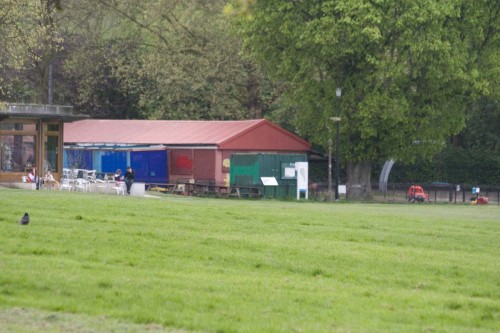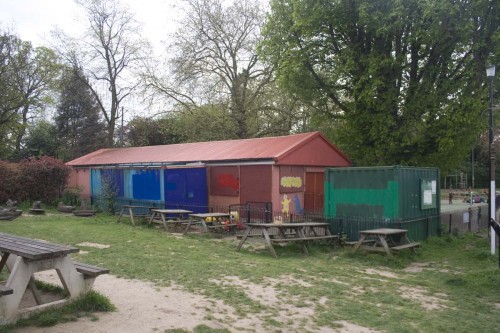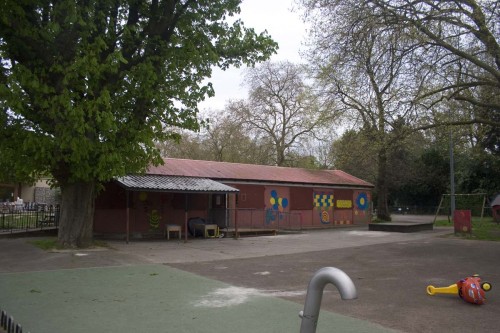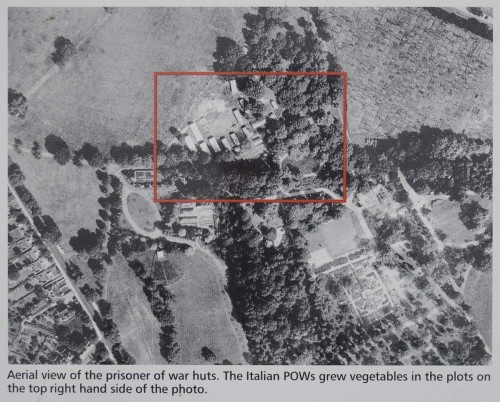It’s a bit odd but when you think of prisoner of war camps from World War 2, it seems likely to think of the rural areas of England away from the populace, not right in the heart of London.
And yet, there were prisoner of war camps within London itself.
Today we’d call them “human shields”, but back then, it was just the most sensible place to put them. And a relic of one such camp still exists in Peckham Rye. Sadly, most of what was left was removed in 2009, but one wartime hut, occupied by Italian prisoners still survives, and is today incongruously, a children’s play area that was welcoming a birthday party when I was there.
Unlike our visions of Prisoner of War camps from the Hollywood movies, while the Peckham Rye camp was indeed surrounded by barbed wire and fences, it was closer to a modern day “open prison” and not at all the sort of nasty environment shown in the movies of their German equivalents.
There was a joke that the high fences were less to keep the Italians in, than the British women out!
As it happened, a large plot of land was set to one side for farming, and were allowed out to go shopping and visit local attractions. They wore a prisoners uniform, and it is presumed there was a nighttime curfew, but other than that, it seems to have been a fairly congenial way to spend the remainder of the war — if you weren’t motivated to want to fight that is.
It might seem odd to have Italian prisoners moved all the way to the UK, but they were initially held in camps in Eritrea, but due to shortages of labour in Great Britain, many of these men were transported to this country from 1942 onwards to undertake agricultural work, bomb damage clearance and construction work in the cities.
Some of them build pre-fab homes for returning soldiers.
Rather sadly, the last Prisoner of War hut is likely to follow the rest and be torn down shortly, as the council has approved funding for a replacement building. It might not look much, but it is historic, so you might not have long to stand there and stare at a curious relic of our wartime past.
A final side note, the B&W photo on the display board next to the remaining hut shows the farmed plots of land, but the main open grasslands of the park seem untouched. That seems a shocking waste of “farmland” at a time of austerity, when even Hyde Park was being torn up for food production. Very odd.











Whether the open grassland was a waste of farm land probably depended on what the soil was like – quite a few older public open spaces are like that because the soil was so poor they weren’t worth farming. Or they may have been grazing the grass (same sort of reason – poor soils support grass better than arable crops)!
Fascinating. I lived at Honor Oak for most of my youth and didn’t know about the camp. My father used to talk to the Italian Prisoners of war held in a similar camp on Doncaster Race Course.
My dad came from Peckham and told me of the pow camp on the rye that he I think ha said he guarded and he was a Bennett
I lived in E.Dulwich and remember the camp clearly .The prisoners wore a brown uniform with an orange colour large diamond shape on the back .I can remember seeing them playing volleyball at the back of the camp which was new to me at the time .Inside the front gate was a lovely flower bed with a sculpture shape wall painted white with top 12 inches in blue
Hi Alan Bird,
I am currently doing an art project on Peckham and the surrounding area, looking at the past present and future. it would be great to hear some more stories if possible?
If you are interested in sharing or having a chat, please email me- maff.rogers@virgin.net or reply on here!!
many thanks Matt
I read your article with interest. I remember that there were some German officers there too some wore the S.S uniforms. My mum and uncle talked to one or two of them through the wire fences (weren’t supposed to) to get their points of views. I seem to remember that there were allotments at Rye Park as well. About 1946/7
Good evening Mr. Danvery, tonight, through a face book site “Pow field 61” I read your comments about the Peckham area where my father and ‘been a prisoner until May 1946, you said that his grandfather was warden at that field and surely will have ‘met my father, although i think that the prisoners were numerous. I hope that his grandfather is still alive but, in any case, I would like to have from you a little more information in proposito.Non know if you are the John Danvery I see on the face book, me on face book are Camillo Puss although my name is Joanna Rays (the translator does not allow me to express myself well, the names translates them into English), if you want we can also contact us by this means, of course privata.Spero chat not to have disturbed and to soon have news of him.
Thank you.
Giovanna Raggi (on Face book: Camillo Micio)
During WW2 my uncle Pete guarded the Italian prisoners at the camp on Peckham Rye. One of the prisoners crafted a ship in a bottle and gave it to my uncle as a gift. My brother still has this today.
When playing football for my primary school in the early 60’s the camp huts were used as changing sheds and the goalposts were housed on the compound. There was a long outside trough with cold water taps which I assume had been the washing facilities for the prisoners.
I refer to the post by Giovanna Raggi… my father was a POW at Peckham Rye and was sent to work at Hartley’s jam factory. POWs seem to have had a lot of freedom as, whilst there, he “befriended” my mother and I arrived 9 months after he was repatriated in 1946. My father married a couple of years later and Giovanna is his daughter from that marriage. I am very pleased to say that Giovanna and I are in frequent contact. Incidentally, my first name translate into Giovanna in Italian!
Italy surrendered to the allies in 1943. I suspect the POWs came to Peckham Rye after that. They could not return to Italy as German military were there opposing the allied advance.
After the surrender of Germany in May 1945 German POWs were there. Repatriation for them could not come at once. I remember Catholics among them singing Stille Nacht at Midnight Mass at the Convent at Honor Oak at Christmas 1945.
My father’s family came from Peckham and my mother’s from Forest Hill. My mother would sometimes shop in Peckham. I recall walking by the Peckham Rye POW Camp with her when I was about 6 and one of the prisoners giving me a little model he’d made. It was probably an aeroplane or a boat.
I’ve often wondered: did all the Italian prisoners return to Italy or did some remain to set up restaurants or even just stalls to introduce the English to Italian cuisine?